Opening 15/11 - 15/11 - 30/01, 2013
-
Riccardo Previdi
BROKEN DISPLAY
Display, evince, exhibit, manifest mean to show or bring to the attention of another or others. To display is literally to spread something out so that it may be most completely and favorably seen: to display goods for sale. To exhibit is to display something in a show: to exhibit the best flowers. They may be both used for showing (off) one’s qualities or feelings: He displayed his wit. He exhibited great surprise. To evince and to manifest also mean to show feelings or qualities: to evince or manifest surprise, interest. 4. flourish, parade, air. 8. See show.
(Dictionary.com)
The English word display contains many meanings. As verb it means to show, exhibit, manifest and flaunt; as a noun: show, demonstration, exhibition, manifestation, and ostentation, among other things. Its origin is to be found in the words – first recorded between 1250 and 1300 – desplayen (from Middle English) and despleier (from Old French), which in turn derive from the Late Latin term displicāre, meaning to explain, to unfold.
The role of this word in our society has grown exponentially of late. For some of its multiple meanings, many languages contain no translation of the English term. Take for instance the screen, the surface on which images appear, increasingly defined as a display, in Italian and in other languages. In the technical parlance of architects this word is used to describe the expositional arrangements in museums and shops. Those working in the art field use it to refer the architecture of an exhibition.
Why has the word had such great success? Perhaps because this mechanism that broadens the vision (to display is literally to spread something out so that it may be more completely and favorably seen: to display goods for sale) is at the basis of any commercial exchange. Perhaps because “seeing better” is a pivotal point for a commercial society.
But what would happen if this mechanism got jammed? What would happen if the screen of that smartphone in our pocket ceased to show images? If our computer wouldn’t turn on? What would happen if shop windows were cleared of goods, arrangements, mannequins and the rest, and the merchandise was simply thrown out? What would happen if the Foxconn factory in Tawian – where the iPhone 5 is assembled – as a result of trivial fight between a security guard and a worker, were to stop production for a few hours?
It was through pondering such questions that Riccardo Previdi came to create his third personal show at Francesca Minini in Milan. A series of abstract compositions realized with mixed techniques on synthetic felt and on transparent PVC film give the show its title: Broken Display. The image generally used for the calibration of monitors, deprived of color, and thus of its main function, links the works together and becomes a kind of wallpaper. The same image but now with colors and scrunched up, and hence geometrically altered, is a triptych painted by the artist’s hand. At the center of the room an aluminium sculpture of human semblance welcomes spectators to the space and invites them to turn their attention to the video installation Tatami.
Display, evince, exhibit, manifest mean to show or bring to the attention of another or others. To display is literally to spread something out so that it may be most completely and favorably seen: to display goods for sale. To exhibit is to display something in a show: to exhibit the best flowers. They may be both used for showing (off) one’s qualities or feelings: He displayed his wit. He exhibited great surprise. To evince and to manifest also mean to show feelings or qualities: to evince or manifest surprise, interest. 4. flourish, parade, air. 8. See show.
(Dictionary.com)
The English word display contains many meanings. As verb it means to show, exhibit, manifest and flaunt; as a noun: show, demonstration, exhibition, manifestation, and ostentation, among other things. Its origin is to be found in the words – first recorded between 1250 and 1300 – desplayen (from Middle English) and despleier (from Old French), which in turn derive from the Late Latin term displicāre, meaning to explain, to unfold.
The role of this word in our society has grown exponentially of late. For some of its multiple meanings, many languages contain no translation of the English term. Take for instance the screen, the surface on which images appear, increasingly defined as a display, in Italian and in other languages. In the technical parlance of architects this word is used to describe the expositional arrangements in museums and shops. Those working in the art field use it to refer the architecture of an exhibition.
Why has the word had such great success? Perhaps because this mechanism that broadens the vision (to display is literally to spread something out so that it may be more completely and favorably seen: to display goods for sale) is at the basis of any commercial exchange. Perhaps because “seeing better” is a pivotal point for a commercial society.
But what would happen if this mechanism got jammed? What would happen if the screen of that smartphone in our pocket ceased to show images? If our computer wouldn’t turn on? What would happen if shop windows were cleared of goods, arrangements, mannequins and the rest, and the merchandise was simply thrown out? What would happen if the Foxconn factory in Tawian – where the iPhone 5 is assembled – as a result of trivial fight between a security guard and a worker, were to stop production for a few hours?
It was through pondering such questions that Riccardo Previdi came to create his third personal show at Francesca Minini in Milan. A series of abstract compositions realized with mixed techniques on synthetic felt and on transparent PVC film give the show its title: Broken Display. The image generally used for the calibration of monitors, deprived of color, and thus of its main function, links the works together and becomes a kind of wallpaper. The same image but now with colors and scrunched up, and hence geometrically altered, is a triptych painted by the artist’s hand. At the center of the room an aluminium sculpture of human semblance welcomes spectators to the space and invites them to turn their attention to the video installation Tatami.
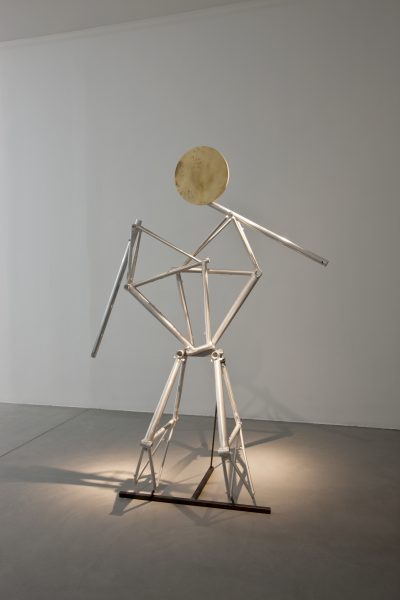 Ciao, 2012Bicycle frames, wood
Ciao, 2012Bicycle frames, wood
232,5×166×75 cm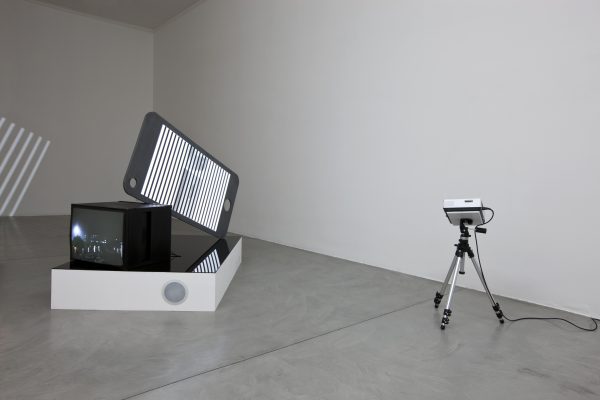 Tatami (no matter where you are, you’re always able to see the one you love), 2012
Tatami (no matter where you are, you’re always able to see the one you love), 2012
Video projection, DVD video, plexiglass, wood
160×120×180 cm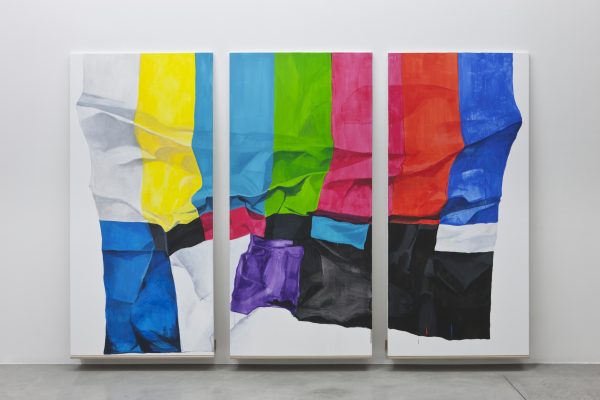 Cimento dell’armonia e dell’invenzione, 2012Acrylic on canvas, 3 pieces
Cimento dell’armonia e dell’invenzione, 2012Acrylic on canvas, 3 pieces
190×90 cm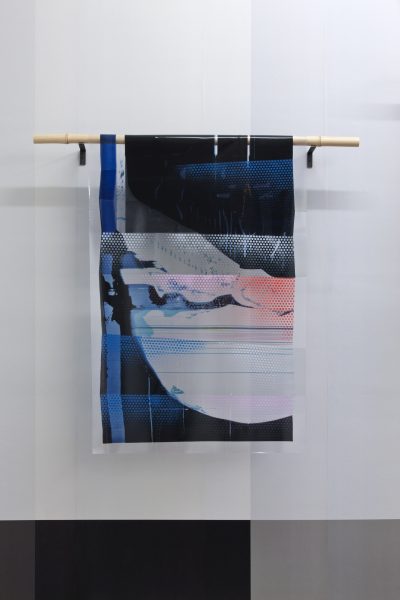 Broken Display, 2012Uv print on PVC
Broken Display, 2012Uv print on PVC
120×120 cm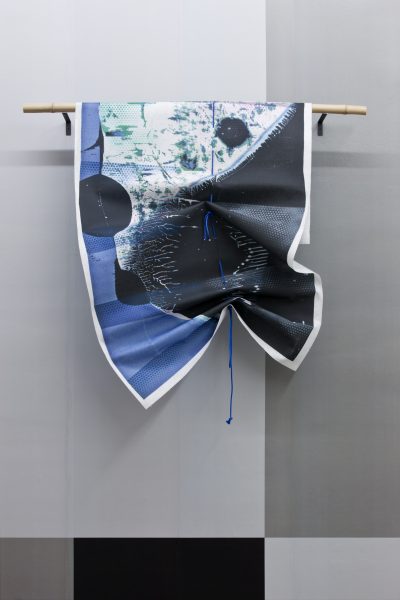 Broken Display, 2012Print on felt, spray paint
Broken Display, 2012Print on felt, spray paint
123×135 cm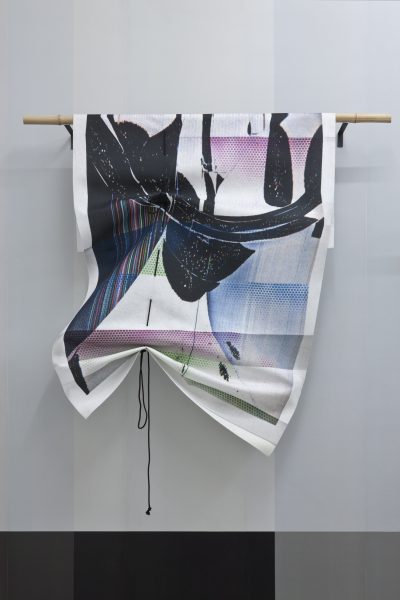 Broken Display, 2012Print on felt, spray paint
Broken Display, 2012Print on felt, spray paint
150×120 cm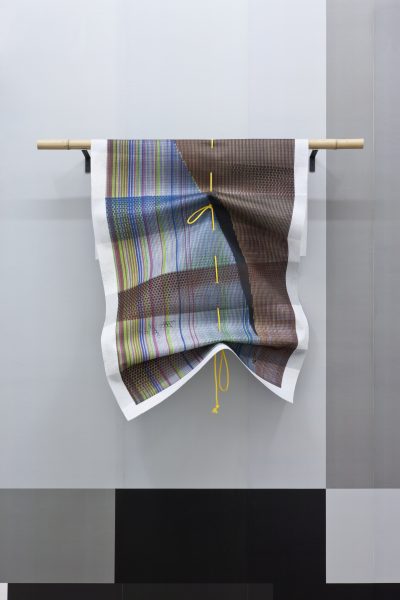 Broken Display, 2012Print on felt, spray paint
Broken Display, 2012Print on felt, spray paint
104×116 cm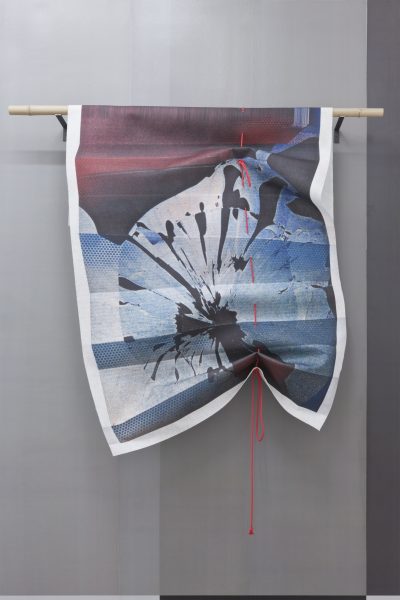 Broken Display, 2012
Broken Display, 2012
Print on felt, spray paint
171×142 cm





























